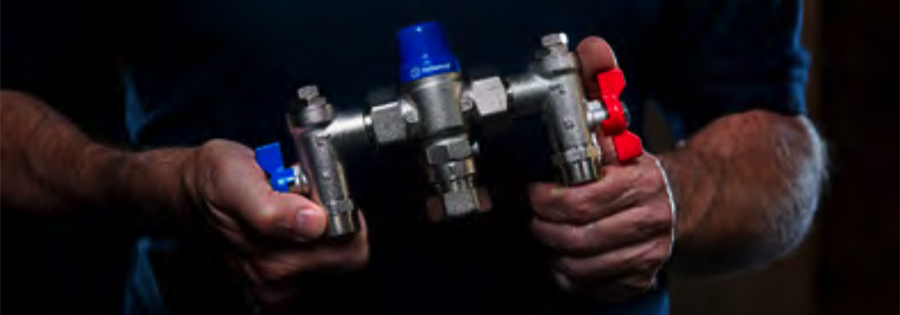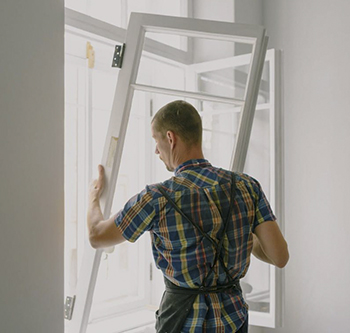Thermostatic mixing valves and water safety
Whether a homeowner or land-lord or a local council, building owners have a duty of care for those living, working, or using their facilities, which is why thermostatic mixing valves (TMV) play a crucial role in all plumbing systems. It is imperative that some form of TMV be specified for every hot water system. The main benefit of a TMV is keeping water at a safe temperature, which therefore prevents scalding and helps stop the build-up of harmful Legionella bacteria. This is achieved by mixing hot and cold-water streams together to ensure a safe temperature at the outlet.
The type of TMV required for an individual application will vary greatly on what kind of building the specification is taking place in, as domestic and commercial buildings have a different requirement to buildings in the healthcare sector.
It is recommended that in domestic and commercial environments, a TMV2 approved valve is specified, and safely installed, tested and maintained to current standards. These valves are designed to reduce the risk of scalding at outlets, while minimising the potential build-up of Legionella bacteria in the pipework that is fed from the outlet side of the valve to the tap. They are typically found under sinks and basins, and never more than 2m away from the outlet they are serving. For buildings occupied by the healthcare sector, such as hospitals, a TMV3 needs to be specified, which functions the same way as a TMV2, but undergoes more rigorous testing, both at the point of installation, as well as every six months after initial sign- off. This is to ensure the safety of the end users, who are likely to be more vulnerable to both scalding and the potential harmful infection from Legionella bacteria.
Where a TMV2 can typically only work with water pressures of 5 bar or below, a TMV3 is safe to work with 10 bars of water pressure.
Water safety in buildings, published by the World Health Organization in 2011, defines thermostatic mixing valves as: ‘Tempering valves that are typically temperature-activated. Used to mix hot and cold water to achieve a predetermined outlet temperature, and that are fitted between the water heater and the point of use to control the distribution temperature. Slightly different temperature ranges are used in some countries.’
Legionnaires' Disease - Operation and Maintenance Log Book (BG 58/2015), written by Reginald Brown and Salim Deramchi, and published by BSRIA in May 2015, defines a thermostatic mixing valve as a: ‘Mixing valve in which the temperature of the water at the outlet is pre-selected and automatically controlled by the valve.’
The above article includes an extract of "Do not get your ABCs confused – all you need to know about TMVs, PRVs and the Tenant Valve" published in the AT journal, issue 144, Winter and written by Richard Bateman, Product Marketing Manager, RWC
--CIAT
[edit] Related articles on Designing Buildings
- A guide to installing thermostatic mixing valves: what, why and how.
- Domestic hot water.
- Mechanical, electrical and plumbing MEP.
- Ofwat.
- Pipework defects, ventilation and airflow rates.
- Pipework.
- Pressure independent control valves.
- Pressure-relief valve.
- Pumps and dewatering equipment.
- Radiator.
- Tap.
- Thermostatic mixing valve.
- Types of valve.
- Types of water.
- Valve.
- Water safety plan WSP
- Water.
Featured articles and news
Skills England publishes Sector skills needs assessments
Priority areas relating to the built environment highlighted and described in brief.
BSRIA HVAC Market Watch - May 2025 Edition
Heat Pump Market Outlook: Policy, Performance & Refrigerant Trends for 2025–2028.
Committing to EDI in construction with CIOB
Built Environment professional bodies deepen commitment to EDI with two new signatories: CIAT and CICES.
Government Grenfell progress report at a glance
Line by line recomendation overview, with links to more details.
An engaging and lively review of his professional life.
Sustainable heating for listed buildings
A problem that needs to be approached intelligently.
50th Golden anniversary ECA Edmundson apprentice award
Deadline for entries has been extended to Friday 27 June, so don't miss out!
CIAT at the London Festival of Architecture
Designing for Everyone: Breaking Barriers in Inclusive Architecture.
Mixed reactions to apprenticeship and skills reform 2025
A 'welcome shift' for some and a 'backwards step' for others.
Licensing construction in the UK
As the latest report and proposal to licence builders reaches Parliament.
Building Safety Alliance golden thread guidance
Extensive excel checklist of information with guidance document freely accessible.
Fair Payment Code and other payment initiatives
For fair and late payments, need to work together to add value.
Pre-planning delivery programmes and delay penalties
Proposed for housebuilders in government reform: Speeding Up Build Out.
High street health: converting a building for healthcare uses
The benefits of health centres acting as new anchor sites in the high street.
The Remarkable Pinwill Sisters: from ‘lady woodcarvers’ to professionals. Book review.
Skills gap and investment returns on apprenticeships
ECA welcomes new reports from JTL Training and The Electrotechnical Skills Partnership.
Committee report criticises UK retrofit schemes
CIOB responds to UK’s Energy Security and Net Zero Committee report.

























